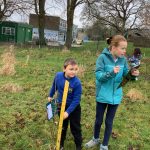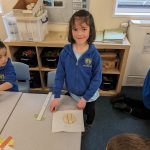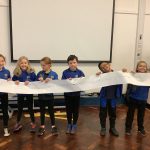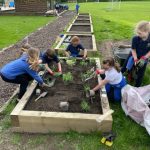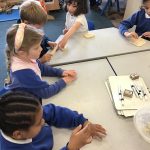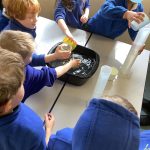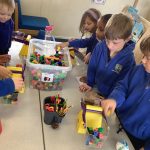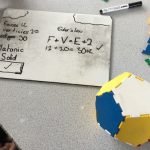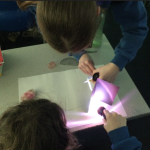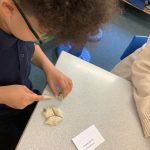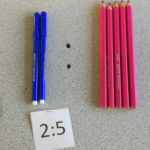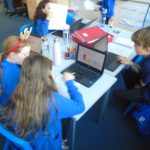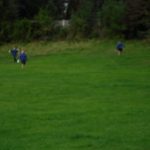What does maths learning look like at Dore Primary School?
Across the school, maths is taught daily so that pupils develop as creative, resilient mathematicians. As maths is such a huge part of the world around us, there are many cross-curricular links and our maths learning is developed through a vast range of other subjects such as Geography, History, Science, Computing and Art.
At Dore Primary School, the White Rose Maths framework is followed by all teachers to support with the planning and delivery of quality maths lessons.
The aim of this approach is to:
- Support children’s ability to make links and connections between mathematical concepts,
- Develop children’s reasoning and problem solving skills
- Increase children’s fluency of number fact recall.
Our calculation policy (see attachment below) has been developed around the use of CONCRETE, PICTORIAL and ABSTRACT methods which support children to “SEE THE MATHS” and apply learning to new concepts.
Concrete – Children use practical apparatus such as base 10, place value counters, Cuisenaire rods, Numicon and plastic coins to complete calculations. The main focus is to investigate new concepts and ideas, develop an understanding of the place value of numbers and recognise links to prior learning.
Pictorial – Children draw images of practical apparatus to encourage them to begin developing mental pictures of calculations and visualise the calculation. Children make links between concrete and abstract representations.
Abstract – Children represent prior learning using mathematical symbols. They consolidate the understanding formed through concrete and pictorial investigation and use digits and symbols to represent calculations.
How does concrete, pictorial and abstract impact children’s learning?
- Children show better retention rates of new concepts when they are introduced using practical apparatus compared to just using abstract symbols
- Using practical apparatus reduces cognitive demand on pupils
- Children develop a deeper understanding of concepts
- Using concrete and pictorial images reduces an overreliance on mathematical rules and encourages a deeper understanding of concepts
- Using practical apparatus address and overcome children’s misconceptions about mathematical concepts

What are the maths non-negotiables?
The maths non-negotiables are key recall facts which are taught in each year group to support children’s maths fluency. At Dore Primary School, children are encouraged to look carefully at questions in order to choose the most efficient method for solving calculations. Developing number fluency allows children to use mental methods to calculate, thus reducing cognitive load and increasing efficiency. In addition to regularly being practised during maths lessons, these recall facts are taught and revised throughout the day as part of classroom routines such as during classroom transitions.
The White Rose 1 minute maths app is great fun for pupils in Foundation and Key Stage 1 to practise learning fluency facts at home. It includes lots of levels for children to work through and aim to beat their latest high scores. It’s free to download and doesn’t require a pupil login.
https://whiterosemaths.com/1-minute-maths
Times Table Rockstars is a brilliant website for practising times tables for children in Y2 and above. Please ask your child’s teacher if you are unsure of your child’s log-in for this useful resource.
https://play.ttrockstars.com/auth/school/student

What is SPADE?
At Dore Primary School, we have developed SPADE (Show it! Prove it! Apply it! Detect it! Explain it!) to encourage children to reason and problem solve as mathematicians. SPADE increases children’s links and connections between different areas of learning and also develops critical thinking skills in maths.

Below are some additional links to support parents with Maths learning:
MATHS – INTENT, IMPLEMENTATION AND IMPACT STATEMENT:
Maths News:
- Y3 Maths – Measuring trees
 In Maths Y3 are looking at Length and perimeter. The children took a metre stick and measured the trees on Kings Croft. The children put the information they had found into a tally chart. We had a great time not only developing our maths skills but also getting lots of fresh air.
In Maths Y3 are looking at Length and perimeter. The children took a metre stick and measured the trees on Kings Croft. The children put the information they had found into a tally chart. We had a great time not only developing our maths skills but also getting lots of fresh air. - Maths- Fractions with salt dough
 Our maths in Y2 has moved onto fractions. Our immersion lesson allowed for our Y2s to create their own pizza’s, bread and cakes using salt dough, integrating fractions to split their creations into halves, quarters and thirds.
Our maths in Y2 has moved onto fractions. Our immersion lesson allowed for our Y2s to create their own pizza’s, bread and cakes using salt dough, integrating fractions to split their creations into halves, quarters and thirds. - Measuring in FS2
 The children have been using their comparing and measuring skills in maths as we explored mass and capcity in the maths sessions we have had since Christmas. The children were knowledgeable about the kind of vocabulary we use when we describe those comparisons. They also measured how much objects weighed using cubes and how much… Read more: Measuring in FS2
The children have been using their comparing and measuring skills in maths as we explored mass and capcity in the maths sessions we have had since Christmas. The children were knowledgeable about the kind of vocabulary we use when we describe those comparisons. They also measured how much objects weighed using cubes and how much… Read more: Measuring in FS2 - Y3 Maths Place value – ordering numbers
 As Mathematicians, to consolidate our understanding of place value we made our own 0-1000 number lines. In groups, we labelled multiples of 10 and 100 then placed random 3 digit numbers on our number lines. Are they all in the right order?
As Mathematicians, to consolidate our understanding of place value we made our own 0-1000 number lines. In groups, we labelled multiples of 10 and 100 then placed random 3 digit numbers on our number lines. Are they all in the right order? - Start of our the Y5 Fantastic Voyage
 Y5H Denmark and Y5P Germany have had a brilliant start to the 2023-24 academic year. Our first learning journey I called Fantastic Voyage and this is an accurate description of the children’s adventure in year 5 so far. As part of their Learning journey we have:
Y5H Denmark and Y5P Germany have had a brilliant start to the 2023-24 academic year. Our first learning journey I called Fantastic Voyage and this is an accurate description of the children’s adventure in year 5 so far. As part of their Learning journey we have: - Our first week in Y2🎉 Welcome back, Year 2 superstars! 🎉 It has been a great first week back at school. We have love exploring all our new classroom areas and taking part in our Y2 learning so far. We are getting ready for another amazing year of learning, achieveing , and making incredible memories together!
- Y5 Veg Patch Project
 Over the past few months, the Y5s have been undertaking the ambitious and challenging task of constructing vegetable beds in order to grow their own produce. We’ve been learning about “farm to fork” and how the fresh produce in our supermarkets is grown. This builds on the children’s Y3 Science learning on plant growth and… Read more: Y5 Veg Patch Project
Over the past few months, the Y5s have been undertaking the ambitious and challenging task of constructing vegetable beds in order to grow their own produce. We’ve been learning about “farm to fork” and how the fresh produce in our supermarkets is grown. This builds on the children’s Y3 Science learning on plant growth and… Read more: Y5 Veg Patch Project - Y1 Maths
 Year 1 have been learning how to half and quarter!
Year 1 have been learning how to half and quarter! - Y1 Maths
 Y1 have been using different units to measure.
Y1 have been using different units to measure. - Maths Y1
 The children learnt how to recognise full, empty, nearly full and nearly empty with water.
The children learnt how to recognise full, empty, nearly full and nearly empty with water. - Y1 Maths
 Year 1 have been measuring the mass of objects with scales.
Year 1 have been measuring the mass of objects with scales. - Y6 – Maths – 3D Shapes: Euler’s Law and Platonic Solids
 As part of our unit of shape, Year 6 children have been exploring 3D shapes. In this lesson, children were investigating Euler’s Law (That, in many 3D shapes, the number of faces plus the number of vertices is 2 more than the number of edges or F+V=E+2), using polydron. Children were also built the 5… Read more: Y6 – Maths – 3D Shapes: Euler’s Law and Platonic Solids
As part of our unit of shape, Year 6 children have been exploring 3D shapes. In this lesson, children were investigating Euler’s Law (That, in many 3D shapes, the number of faces plus the number of vertices is 2 more than the number of edges or F+V=E+2), using polydron. Children were also built the 5… Read more: Y6 – Maths – 3D Shapes: Euler’s Law and Platonic Solids - Y6 – Science – Reflection
 In Science this half term, Year 6 are learning about light and seeing. Having established last week that light travels in straight lines, this week, we have been exploring how light can change its direction of travel by reflecting off a surface, always reflecting at an equal angle to which it approached the surface. Children… Read more: Y6 – Science – Reflection
In Science this half term, Year 6 are learning about light and seeing. Having established last week that light travels in straight lines, this week, we have been exploring how light can change its direction of travel by reflecting off a surface, always reflecting at an equal angle to which it approached the surface. Children… Read more: Y6 – Science – Reflection - Y2 Maths – fractions of shapes
 We have been learning about halves, thirds and quarters. This week we used salt dough to help us represent different fractions e.g. two thirds. If you want to practise this learning at home, you could play on ’Fractonio’s Pizza’ on PurpleMash.
We have been learning about halves, thirds and quarters. This week we used salt dough to help us represent different fractions e.g. two thirds. If you want to practise this learning at home, you could play on ’Fractonio’s Pizza’ on PurpleMash. - Y4 Bread Baking
 To finish our ‘Food for Thought’ learning journey, Y4 baked bread! We thought about some of the changes of state taking place in the process – including the reaction of yeast, the mixing of water and flour, and how butter can be made from shaking whipping cream (for a long time). Viki Garbett from twiddlefood… Read more: Y4 Bread Baking
To finish our ‘Food for Thought’ learning journey, Y4 baked bread! We thought about some of the changes of state taking place in the process – including the reaction of yeast, the mixing of water and flour, and how butter can be made from shaking whipping cream (for a long time). Viki Garbett from twiddlefood… Read more: Y4 Bread Baking - Y6 – Making ratios
 In maths, Year 6 have been learning about ratio. To help the children initially get to grips with what a ratio is, children created ratios using objects from around the room, simplifying the ratios when needed. This activity also helped demonstrate to pupils how flexible ratios can be compared to other part-whole concepts, such as… Read more: Y6 – Making ratios
In maths, Year 6 have been learning about ratio. To help the children initially get to grips with what a ratio is, children created ratios using objects from around the room, simplifying the ratios when needed. This activity also helped demonstrate to pupils how flexible ratios can be compared to other part-whole concepts, such as… Read more: Y6 – Making ratios - Y3 Hour of code – computing
 Year 3 celebrated the hour of code by using computers to create and analyse databases. This meant working collaboratively to first choose the fields to fill in, then adding this information. We learnt the databases hold losts of information but can be used to quickly answer questions.
Year 3 celebrated the hour of code by using computers to create and analyse databases. This meant working collaboratively to first choose the fields to fill in, then adding this information. We learnt the databases hold losts of information but can be used to quickly answer questions. - Y2 – Maths – Empty number lines!
 Today, the children took their learning about empty numberline and went outside to apply it! They worked with a partner and made their own 0-10 or 0-100 numberlines and tested one another to estimate the position of different numbers.
Today, the children took their learning about empty numberline and went outside to apply it! They worked with a partner and made their own 0-10 or 0-100 numberlines and tested one another to estimate the position of different numbers. - Y1 Greater than and less than
 The children have done a great job learning about the greater than and less than symbols this week and have been using them to compare numbers.
The children have done a great job learning about the greater than and less than symbols this week and have been using them to compare numbers. - Y4 Outdoor Maths
 For a change to a usual maths lesson, we put our learning on our new Outdoor Learning posts around the school field, so children were able to get some exercise while they were working. It proved very popular!
For a change to a usual maths lesson, we put our learning on our new Outdoor Learning posts around the school field, so children were able to get some exercise while they were working. It proved very popular!

